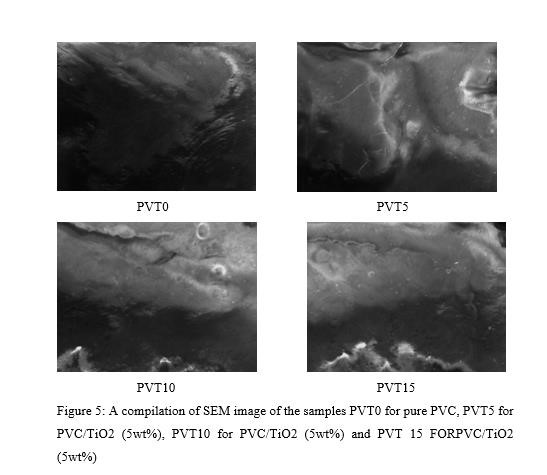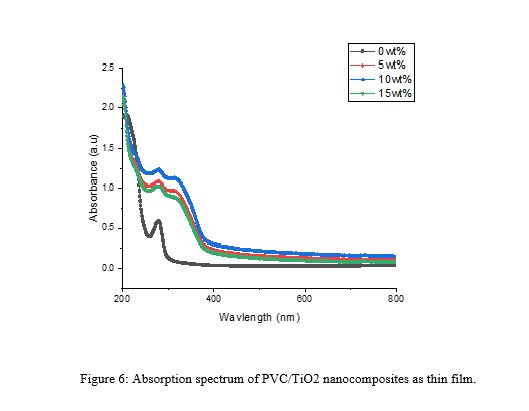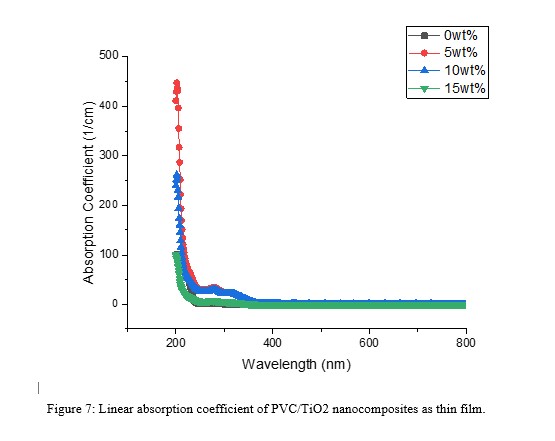Ijraset Journal For Research in Applied Science and Engineering Technology
- Home / Ijraset
- On This Page
- Abstract
- Introduction
- Conclusion
- References
- Copyright
Optical Limiting Methods by Z-Scan Technique for Non-Linear Optical Absorption of PVC/TiO2 Nanocomposite
Authors: Muhammad Arif Bin Jalil
DOI Link: https://doi.org/10.22214/ijraset.2024.64343
Certificate: View Certificate
Abstract
To further our grasp of photonics technology, our work focuses on thin-film PVC/TiO2 nanocomposites. Nanocomposites composites were created by combining TiO2 nanoparticles with Polyvinyl Chloride (PVC) as the polymer matrix. The thin film was fabricated using the casting method. Spectral analysis was used to determine the absorbance parameters and compute the linear absorption coefficient. The nonlinear refractive index and nonlinear absorption coefficient were measured using a single beam Z-scan approach with a CW diode pumped solid state (DPSS) laser (Coherent Verdi-V5, 532 nm) acting as the excitation laser at 50mW. Peak absorption was measured at 280 nm, and as the percentage of TiO2 nanoparticles grew, more absorption was seen. The nonlinear absorption coefficient was determined to be 1x10?5 cm/W at (0.5342, 1.3585, 1.5999, and 0.0253). The poor structure arising from all of the sample morphologies affects the materials\' NLO absorption. Nonetheless, they seem like good options for optical limiting applications given the positive value of NLO absorption.
Introduction
I. INTRODUCTION
The intriguing field of nonlinear optics (NLO) in physics studies the complex interactions between matter and light that go beyond the scope of linear optics. Numerous nonlinear optical phenomena, including dynamic amplification, four-wave mixing, and sum and difference frequency generation, have been found by researchers over the years [1].Every discovery broadened our knowledge of the interplay between light and matter and made it possible to study optical phenomena.The creation of novel nonlinear optical components and devices is an additional field of research. Compact and effective nonlinear optical devices like frequency converters, optical switches, and optical limiting are being designed and produced [2].These advancements are meant to pave the path for further technological breakthroughs while simultaneously enhancing the performance of currently in use optical devices. On the other hand, polymer materials have come to be as flexible and potential nonlinear optics (NLO) choices. Polymer material development has made significant progress in recent years. It offers various interesting qualities, including low cost, simplicity of production, flexibility, and tunability of properties [2]. These features make polymers highly desirable for a variety of applications, including optics and photonics. Furthermore, doping polymers with suitable substances improves their nonlinear optical characteristics even further [3]. Doping can change the refractive index, increase nonlinear susceptibility, and improve polymer matrix stability [2,4]. As previously indicated, materials containing nanoparticles have revolutionized NLO by offering exceptional control over light-matter interactions at the nanoscale. By acting as doping agents, nanoparticles enhance the nonlinear optical properties of NLO materials [5]. By incorporating nanoparticles into host materials, one may regulate the characteristics and reactions of the composite material. Higher nonlinear susceptibility and better optical response are two examples of the increased nonlinear effects brought forth by this process [5].Therefore, it has been shown that adding nanoparticles as doping agents to polymer matrices can help modify and enhance the nonlinear optical properties of composite materials, which is advantageous for NLO applications including optical switching and limiting.
II. MATERIALS AND METHODS
The first step was adding 80 mg of PVC supplied by Sigma-Aldrich to 1.0 mL of tetrahydrofuran (THF). Agglomerates were helped to dissolve and were prevented by using a magnetic stirrer with an angular velocity of 400 rpm that was timed for one hour at room temperature. A tidy, transparent solution was derived from the PVC/THF solution. Furthermore, TiO2 (titanium dioxide) was also purchased from Sigma-Aldrich. Thirteen-nm-sized nanoparticles in weight percentages of 0, 5, 10, and 15 were gradually added to a mixture of PVC and THF.
After that, the mixture was stirred for two hours using the same configuration until a satisfactory homogeneity was reached. Lastly, the solution was poured consistently on a glass petri dish and leave the sample one day at room temperature for it to dry. After a day, the film was readily removed and the thin film of pure PVC and nanocomposites (PVC/TiO2) of varying concentrations were obtained.
The morphology of the samples was studied using scanning electron microscopy (SEM) brand JSM-5510LV, JEOL. The samples were set up inside the SEM chamber and exposed to a focus electron beam voltage of 5kV at 500 ????m. ImageJ analysis software was also used to determine the thickness of the samples [6]. The linear transmittance spectra of the samples were also examined with a UV-VIS-NIR spectrophotometer from SHIMADZU CORP UV-3600 Plus . A CW diode pumped solid state (DPSS) laser (Coherent Verdi-V5, 532 nm) was employed as the excitation laser at 50mW. Two silicon amplified photodetectors (PDA55, Thorlabs) were used in the setup. The material sample was first placed at the focal plane of a lens system and was mounted into a precision motorized stage (LTS-300, Thorlabs) with jog step of 300 mm. The sample was then scanned along the axial direction with a focused laser beam. The focused laser was split by a 50:50 beam splitter after passed through the samples and were detected by both detectors. One of the pair of photodetectors was positioned after an aperture or closed z-scan which will be used to study the mechanisms that result in nonlinear refraction, whereas the other was positioned in front of a lens or open z-scan which will be sensitive to the nonlinear absorption reaction. Both of information was recorded by oscilloscope.
III. RESULTS AND DISCUSSION
In this study, the morphology observation for PVC/TiO2 of different concentration are retrieved. SEM images of all four PVC/TiO2 nanocomposites via SEM machine at a voltage of 5 kV. SEM micrographs of PVT0, PVT5, PVT10, and PVT15 samples at a 500 ????m scale are shows in Figure 5. Visual observation demonstrates that pure PVC thin film and PVC/TiO2 thin films with (5,10, 15) wt% concentration shows higher surface roughness. Based on PVT5, PVT10 and PVT15, the nanofillers are seem dispersed unequally in the host material. A rise in surface roughness could suggest a change in the material's morphology and a smooth and uniform surface, as in thin films is much more desirable for achieving maximum transmission and reflection of material towards [6] light which later would affect the NLO absorption response.

Figure 6 displays the UV-visible absorption spectrum of PVC and PVC/TiO2 nanocomposites as thin films. The absorbance of PVC/TiO2 nanocomposites is high in the UV region, indicating that the behavior of TiO2 nanoparticles is responsible for the absorption peak at 280 nm. In contrast, the absorbance of pure PVC is low in both the visible and UV regions. This suggests that it has the ability to absorb UVA (280–350 nm) light. In contrast to the dopped concentrations of 5wt% and 10wt%, the sample for the concentration of 15wt% exhibits reduced peak absorption. because the surface structure is so poor.

The linear absorption coefficient spectrum of PVC/TiO2 nanocomposites and pure PVC are shown in Figure 7 as thin films that vary with the wavelength of light absorbed. Because the absorption coefficient values for thin film samples are inversely proportional to the sample thickness, there was a considerable difference in these results. There was minimal difference observed in the values of the UV and visible regions in the thin film samples. With longer wavelengths, all samples displayed a decrease in value; however, the quantity of TiO2 nanoparticles in the nanocomposites increased, especially at shorter wavelengths.

Equation 3.6.2 was used to get the Rayleigh length, which came out to be 8.982 mm. The beam's radius at the focus was found to be 36 ????m. The Z-scan technique requires that it is larger than the sample thickness [2,5]. TiO2 nanoparticles were identified as the cause of the study's notable nonlinear effect. At 532 nm, the pure PVC showed a somewhat nonlinear optical response when analyzed with the same methodology.

Based on Figure 9, the valley with the highest concentration of TiO2 nanoparticles was deeper than the valley with the lowest concentration in the samples. This suggests that nonlinear absorption is higher at high concentrations than at low concentrations. However, in the case of PVC/TiO2 15wt%, the supposedly result could not obtained due to the poor structure fabrication which affect the transmittance and absorption of the laser. The nonlinear absorption coefficient is determined using equation 3.6.1, where ???????? is the single valley value acquired from the open Z-scan data collected. Table 2 show the values of ????????0, ????????????????, and ???? of PVC/TiO2 nanocomposites as thin films. The values of these parameters differed among nanocomposites samples are due to their absorption coefficient and the thickness of the sample, which varies between each other.
Conclusion
The current work examines and measures the nonlinear absorption properties of PVC/TiO2 nanocomposite in order to provide a research framework. Sadly, the prepared samples did not satisfy the fundamental specifications for thin film surfaces. Still, the information obtained is valuable for researching how morphology and structure are affected by lasers. The Z Scan Technique has also been shown to be used in the current work to acquire the NLO characteristics. The technique approach produced outcomes that were fairly comparable to what other researchers had found. Because of the positive levels of nonlinear absorption, PVC/TiO2 is a promising choice for optical limiting.
References
[1] Shen, Y., Tian, B., Zhou, T., & Gao, X. (2023). Inhomogeneous reduced Maxwell– Bloch system in nonlinear optics: Darboux-transformation and solitonic issues. Optik, 285, 170949. https://doi.org/10.1016/j.ijleo.2023.170949 [2] Shanshool, H. M., Yahaya, M., Yunus, W. M. M., & Abdullah, I. Y. (2016). Influence of polymer matrix on nonlinear optical properties and optical limiting threshold of polymer-ZnO nanocomposites. Journal of Materials Science: Materials in Electronics, 27(9), 9503–9513. https://doi.org/10.1007/s10854-016-5001-8 [3] Tang, R., Chen, H., Zhou, S., Xiang, W., Tang, X., Liu, B., Dong, Y., Zeng, H., & Li, Z. (2015). Dendronized hyperbranched polymers containing isolation chromophores: design, synthesis and further enhancement of the comprehensive NLO performance. Polymer Chemistry, 6(31), 5580–5589. https://doi.org/10.1039/c5py00155b [4] Wu, W., Huang, Q., Zhong, C., Ye, C., Qin, J., & Li, Z. (2013). Second-order nonlinear optical (NLO) polymers containing perfluoroaromatic rings as isolation groups with Ar/ArF self-assembly effect: Enhanced NLO coefficient and stability. [5] Polymer, 54(21), 5655–5664. https://doi.org/10.1016/j.polymer.2013.07.073 [6] Mohammed Shanshool, H., Yahaya, M., Mat Yunus, W. M., & Abdullah, I. Y. (2016). [7] USING Z-SCAN TECHNIQUE TO MEASURE THE NONLINEAR OPTICAL PROPERTIES OF PMMA/ZNO NANOCOMPOSITES. Jurnal Teknologi, 78(3). https://doi.org/10.11113/jt.v78.7461 [8] Ramazanov, M. A., Rahimli, A. M., & Hajiyeva, F. V. (2020). The influence of titanium dioxide (TiO2) nanoparticles on the structure, optical and dielectric properties of polyvinyl chloride (PVC). Modern Physics Letters B, 34(28), 2050310. https://doi.org/10.1142/s0217984920503108 [9] Heiba, Z. K., El-Naggar, A. M., Kamal, A. M., Abd-Elkader, O. H., & Mohamed, M. B. (2023). Optical and dielectric properties of PVC/TiO2/TBAI ionic liquid polymer electrolyte. Optical Materials, 139, 113764. https://doi.org/10.1016/j.optmat.2023.113764 [10] Nonlinear optical characteristics of Nile blue films doped with the polymers PMMA, [11] PVC and their blend by using z-scan technique. (2017b). Iraqi Journal of Science, 58(4A). https://doi.org/10.24996/ijs.2017.58.4a.8 [12] Tillmann, W., Dias, N. L., Kokalj, D., Stangier, D., Hein, M., Hoyer, K., Schaper, M., D, G., Oltmanns, H., & Meißner, J. (2022). Tribo-functional PVD thin films deposited onto additively manufactured Ti6Al7Nb for biomedical applications. Materials Letters, [13] 321, 132384. https://doi.org/10.1016/j.matlet.2022.132384 [14] Seibertz, B. B. O., & Szyszka, B. (2023). P-type nickel oxide deposited by reactive hollow cathode gas flow sputtering for the potential usage in thin-film transistors. Thin Solid Films, 778, 139887. https://doi.org/10.1016/j.tsf.2023.139887 [15] Jabbar, A. S., Abbas, S. I., & Al-zubaidy, M. H. (2018). Studying the Linear and Nonlinear Optical Properties by Using Z-Scan Technique for CdS Thin Films Prepared by CBD Technique. Applied Physics Research, 10(3), 7. https://doi.org/10.5539/apr.v10n3p7 [16] Liu, W. W., Zeng, X., Lin, L., Qi, P. F., & Zhang, N. (2021). Spectral domain Z-scan technique. Optics and Lasers in Engineering, 146, 106693. https://doi.org/10.1016/j.optlaseng.2021.106693
Copyright
Copyright © 2024 Muhammad Arif Bin Jalil. This is an open access article distributed under the Creative Commons Attribution License, which permits unrestricted use, distribution, and reproduction in any medium, provided the original work is properly cited.

Download Paper
Paper Id : IJRASET64343
Publish Date : 2024-09-25
ISSN : 2321-9653
Publisher Name : IJRASET
DOI Link : Click Here
 Submit Paper Online
Submit Paper Online

